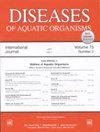Brome mosaic virus (BMV) capsid protein virus-like particle-delivering dsRNA targeting VP28 gene of white spot syndrome virus (WSSV) through feed reduced Penaeus vannamei shrimp mortality from WSSV infection
IF 1.2
4区 农林科学
Q3 FISHERIES
引用次数: 0
Abstract
Numerous strategies have been investigated to combat viral infections in shrimp, specifically targeting the white spot syndrome virus (WSSV) that has caused outbreaks worldwide since the 1990s. One effective treatment involves intramuscular application of dsRNA-mediated interference against the viral capsid protein VP28. However, this approach presents challenges in terms of individual shrimp management, limiting its application on a large scale. To address this, our study aimed to evaluate the efficacy of oral delivery of protected dsRNA using chitosan nanoparticles or virus-like particles (VLPs) synthesized in brome mosaic virus (BMV). These delivery systems were administered before, during, and after WSSV infection to assess their therapeutic potential. Our findings indicate that BMV-derived VLPs demonstrated superior efficiency as nanocontainers for dsRNA delivery. Notably, the treatment involving vp28 dsRNA mixed in the feed and administered simultaneously to shrimp already infected with WSSV exhibited the highest survival rate (48%), while the infected group had a survival rate of zero, suggesting the potential efficacy of this prophylactic approach in commercial shrimp farms.通过饲料传递针对白斑综合征病毒(WSSV) VP28基因的衣壳蛋白病毒样颗粒可降低凡纳滨对虾对白斑综合征病毒(WSSV)感染的死亡率
本文章由计算机程序翻译,如有差异,请以英文原文为准。
求助全文
约1分钟内获得全文
求助全文
来源期刊

Diseases of aquatic organisms
农林科学-兽医学
CiteScore
3.10
自引率
0.00%
发文量
53
审稿时长
8-16 weeks
期刊介绍:
DAO publishes Research Articles, Reviews, and Notes, as well as Comments/Reply Comments (for details see DAO 48:161), Theme Sections and Opinion Pieces. For details consult the Guidelines for Authors. Papers may cover all forms of life - animals, plants and microorganisms - in marine, limnetic and brackish habitats. DAO''s scope includes any research focusing on diseases in aquatic organisms, specifically:
-Diseases caused by coexisting organisms, e.g. viruses, bacteria, fungi, protistans, metazoans; characterization of pathogens
-Diseases caused by abiotic factors (critical intensities of environmental properties, including pollution)-
Diseases due to internal circumstances (innate, idiopathic, genetic)-
Diseases due to proliferative disorders (neoplasms)-
Disease diagnosis, treatment and prevention-
Molecular aspects of diseases-
Nutritional disorders-
Stress and physical injuries-
Epidemiology/epizootiology-
Parasitology-
Toxicology-
Diseases of aquatic organisms affecting human health and well-being (with the focus on the aquatic organism)-
Diseases as indicators of humanity''s detrimental impact on nature-
Genomics, proteomics and metabolomics of disease-
Immunology and disease prevention-
Animal welfare-
Zoonosis
 求助内容:
求助内容: 应助结果提醒方式:
应助结果提醒方式:


